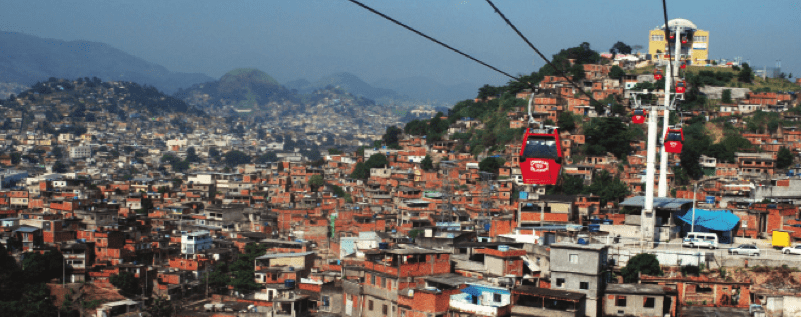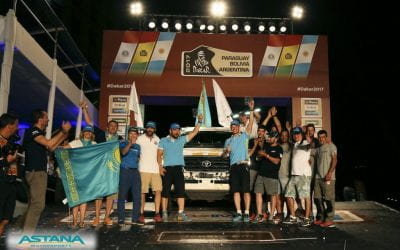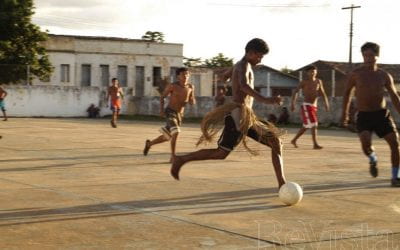
Photo Courtesy of GSD Rio Studio.
Two major international sporting events attract wide audiences in many countries—three if we treat separately, as do the Olympic Committee (IOC) and television networks since 1994, the Winter Olympics and the Summer Olympics. Then there’s the World Cup of soccer, or as called outside of the United States, football. These events have certain things in common. They occur every four years; they have huge television and international audiences; the location of the event is different each time; there is some discussion of bribery in choosing the location (generally because such bribery exists); and much controversy about the outcome of particular sporting events is certain to occur. Each event is the property of a private organization, which is responsible for choosing the location, overseeing the nature of local arrangements and the rules regarding participants and selling the international television contracts. This private organization also does everything it can to protect the monopoly of the event’s logo, apparel and related goods.
In 2014, the World Cup will be held in Brazil, and then in 2016, Rio de Janeiro will host the Summer Olympics. Many in Brazil are anticipating profits and transformations of the country’s infrastructure. Yet, are those expectations realistic?
One thing is certain: every time, the competition to become the location of these events has recently become rather fierce, with a number of cities or countries competing heavily for the rights to host the event, cities for the Olympics, countries for the World Cup. The nature of the bidding is the first step in what often becomes a financial disaster. It is required that the hosts provide an extended infrastructure for the games, including facilities for the actual events as well as housing for Olympic participants. The hope, seldom if ever realized, is that the stadia and arenas for sporting events will serve a useful purpose in future years for the city’s population, while the Olympic Village will be sold to provide housing for residents. There are often other problems that serve to limit gains (or, more likely, to increase losses). The principal argument for benefit is the hoped-for expectation of attracting customers from outside the city, who would provide revenues for hotels, restaurants and ticket sales. These expectations, however, are not often met, and revenue generally falls short of the amount projected at the time of competing for the event.
Also, rather traditionally, the several years that lag between the competition for hosting the events and the actual event see an increase in the costs above projections, costs which must be met by the hosts in fulfillment of their obligations.
It is the general shortfall of revenues and the over-run of costs that account for the major financial problems confronted by the host. But, also important, is the nature of the commitments made to obtain the events, and the failure of the post-event expectations about the use of constructed facilities to be realized, meaning that much of the construction is usually never utilized to the anticipated extent.
With only several exceptions, the Olympics and World Cup had meant severe financial losses for the hosts. Yet, given this knowledge, the competitions to hold these events are highly sought after, whether due to excessive optimism or the belief that international prestige is worth the cost. To which the basic question would be—what price prestige, or international stature? Only the 1984 summer Olympics in Los Angeles showed a profit. All other summer and winter Olympics experienced losses—despite the frequently lucrative television contracts which have apparently become the primary financial supporter of the Olympics. Although there had been knowledge of corruption and also some complaints of the manner in which the IOC operated, no real important attacks occurred that threatened to change the nature of the selection procedure.
The first modern summer Olympics took place in Athens in 1896, with 14 nations participating. They have since taken place every four years, except during World Wars I and II, the most recent being the Beijing Olympics in 2008, with more than 200 nations participating. The winter Olympics began in 1924 and, except during World War II, took place every four years (until 1992) in the same year as the summer Olympics. Then, due to the benefits to the IOC of splitting the two Olympics, and thus gaining from favorable television contracts, the next winter Olympics was held in 1994, and it has since taken place every four years. The World Cup, now presided over by the English soccer organization, FIFA, held its first event in 1930, and then it has taken place every four years except for the WW II years. The summer Olympics had, after 1900, included a soccer competition, and this has continued except for 1932, but this event has lost its prestige value relative to the World Cup.
Little is known about the financial aspects of the early Olympics, although it is believed that the 1984 Los Angeles summer Olympics was the first (and probably the last) of the games to show a positive profit. There have been a number of financial horror stories, of the host city losing large sums of money, with costs exceeding expectations while revenue fell below what had been expected. The Montreal summer Olympics cost $1.2 billion, leaving a debt of $750 million that was not fully paid off until about two years ago. The 1992 Barcelona Olympics cost about $10.7 billion and left a debt for the government of $6.1 billion. The 2004 Athens Olympics cost about $9 to 10 billion, a figure equal to about 5% of Greece’s GNP, leaving a net debt of about $11.5 billion. Costs were only part of the problems faced by Athens, as the demand was unexpectedly small. Only an estimated two-thirds of the tickets were sold, and the number of visitors to Greece fell by about 12 percent from the previous year.
The 2008 Beijing Olympics cost about $43 billion. In the cases of Athens and Beijing, much of the financial difficulty was due to the requirements for building infrastructure for the games, which generally meant new stadiums and arenas for their events. In Athens, 21 of the 22 built stadiums have been left underutilized, and these often have some continued costs of maintenance. A similar outcome occurred in China, where, despite the $43 billion cost, many of the new facilities have no use. No permanent use was found for the very expensive ($500 million) new stadium. It now appears that it will be made into a shopping mall while other smaller stadiums are to be demolished. The Olympic Park built for Sydney, for the 2000 games, has not been utilized. And after the 2010 World Cup in South Africa, new stadiums remained empty, the residue of a cost of $5.4 billion. The winter Olympics of 2010 in Vancouver has similarly led to financial difficulties. The early expectation that the Olympic Village would cover its costs by being sold for housing has not been fulfilled: fewer than half of the apartments have been sold, the shortfall contributing to the overall debt from the games of $743 million. This was, however, considerably less than the loss in the 1998 winter Olympics in Japan, where a cost of $13-14 billion ended with a debt of $11 billion.
Important in creating loss for the host city of Olympics and the World Cup are the regional requirements for infrastructure. As part of the bill for the 2002 World Cup, Japan was required to build seven new stadiums and refurbish three more, at a cost of $4.5 billion, while South Korea built ten new stadiums at a cost of $2 billion. These are now generally referred to as “white elephants.” The largest of the Japanese stadiums, 64,000 seats, cost $667 million to build. After the World Cup the city paid $6
million per year to maintain a facility for a local team that barely drew 20,000 fans.
The Montreal Olympic Stadium was initially budgeted at $150 million, but when it was completed it cost $1.47 billion including repairs, charges, and interest. This made a substantial contribution to Montreal’s debt of $1 billion. The home of the money-losing Montreal Expos of the National League until they left for Washington in 2004, the stadium now has limited uses for sporting and other events. It has no main tenant and is now called “The Big One,” a reference to its financial position.
The expectations of continued deficit expenditures are seen for both the 2012 Olympics to be held in London, and the 2014 World Cup to be held in Brazil. Brazil’s 12 host cities have been slow in completing the twelve stadiums and thirteen airports (plus 50 transportation projects) it promised FIFA, and there is presently talk of a lawsuit by FIFA to encourage Brazil to complete these pieces of infrastructure. At present the estimated cost is about $11.2 billion, most for infrastructure. London put in a bid for the 2012 summer Olympics at the time at an estimated cost of $2.4 billion. Last heard, the estimated cost was about $9 billion, most to be provided by a public subsidy. It is probable that the subsidy will be in the 80-90% range of some early Olympics—90% (Montreal 1976) and 82% (Munich 1972).
By now the main source of revenues for the Olympics has been the sale of TV broadcasting rights, mainly via sales to the U.S. networks. These rights belong to the IOC, and the organization controls the distribution to local committees, a share that was about 30% in 2000. After several decades of rapid rise in fees paid, this increase has recently been slowed. In the post-1980 period, the demands of television led to a fundamental change in the rules of eligibility, permitting professionals as well as amateurs to participate, and allowing participants to receive cash rewards for performances. The most dramatic shift to professionalism in the Olympics came when the 1992 U.S. basketball team shifted from completely college and amateur players to National Basketball Association All-Stars, the so-called Dream Team. This shift was made for two reasons—one, to make things more appealing to television, but also as a response to failure to win in earlier years, and as a nationalistic desire to reassert U.S. supremacy in this sport.
What may seem puzzling, given the near certainty of a loss of substantial magnitude, is the increased desire of more cities to obtain rights to hold these events. In 1984 only one city, Los Angeles, was bidding for the Olympics, successfully. By 2012 it was up to nine cities, and for 2016 it was 12.
In the United States, cities frequently provide some subsidies to their professional sports franchises through the building of stadiums and arenas. It is well established that these cities do not cover costs. The justification involves some non-pecuniary or non-financial explanations—such as municipal pride—how can you regard yourself as a major city without an NFL franchise, prestige of having a major league team, of improving city spirits, of gaining attention from others. These are some of the explanations for undertaking an activity that is expected to lose money. These explanations are, of course the rationale for seeking an Olympics or a World Cup, although on a greater scale given their greater costs. Thus expecting financial losses, based on the past record, is not itself a deterrent from bidding for these events.
The combination of the World Cup in 2014 and the Summer Olympics in 2016 promises to have a negative impact on Brazil’s financial position. Brazil’s construction of the necessary infrastructure is currently behind the projected schedule due to poor planning and financial constraints and it is not clear if they will be able to complete their commitments as to thenumber and quality of airports, stadiums, and ground transportation. How the issue will be resolved if Brazil does keep its promises remains to be seen, although the Brazilian officials claim that all will be completed by the start of the World Cup.





